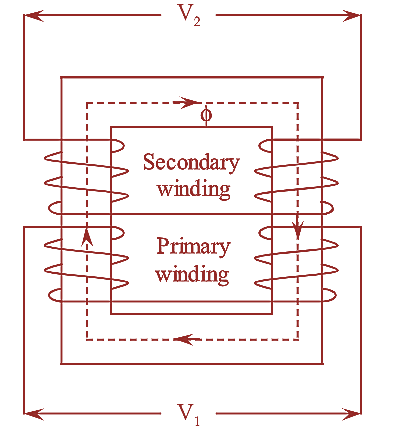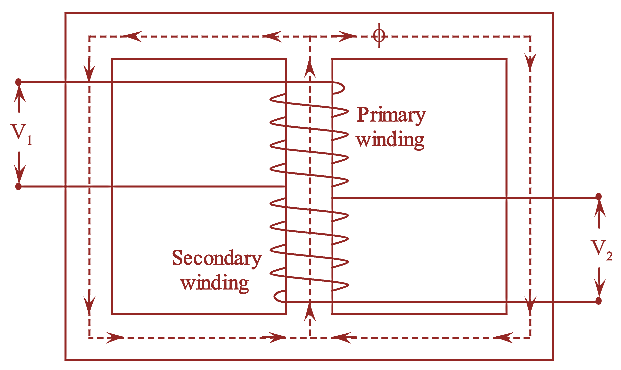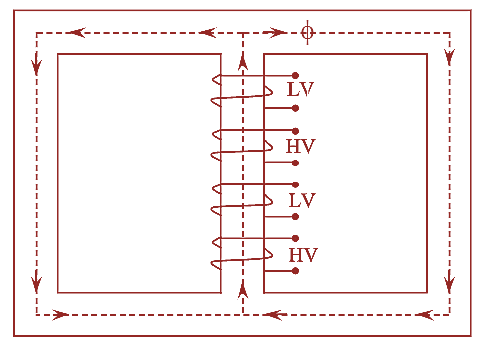Depending upon the type of core used there are two types of transformers in practice. They are,
- Core type transformer
- Shell type transformer.
Core Type Transformer

Figure 1: Core Type Transformer.
The schematic representation of core type transformer is shown in figure (1). The core of this transformer is rectangular in shape and consists of two limbs. Cylindrical type winding coils are used in this type of transformer. The primary and secondary windings are both wound on different limbs as shown in figure (1). Here, the winding surrounds a considerable part of the core. There is only one path for the flux to flow which is through the yoke. Hence, core type transformers have only one magnetic circuit.

Figure 2.
Even though, most of the flux is confined to high permeability core of the transformer. There is always some flux leaking through the yoke and non-magnetic materials surrounding the core. This small amount of flux is known as leakage flux. It should always be kept in mind that this leakage flux has to be minimized as far as possible so that the performance of transformer can improved. Hence in practical condition instead of placing the windings of a core transformer on different limbs, they are interleaved as shown in figure (2), i.e., half of the primary winding and half of the secondary winding has been placed concentrically on each limb due to which the leakage flux reduces.
Shell Type Transformer

Figure 3: Shell Type Transformer.
The schematic representation of shell type of transformer is shown in figure (3). The core of the transformer consists of three limbs. Sandwich type or multi-layer type windings are used in this type of transformer. The primary’ and secondary’ windings are both wound on the same limb i.e., the central limb. Hence the core surrounds a considerable portion of the windings. The flux in the transformer divides equally in the central limb and flows through the outer two limbs. Therefore, the shell type transformer have two magnetic circuits. In actual construction, in order to reduce the leakage flux, the low voltage and high voltage windings are interleaved on the central limb as shown in figure (4).

Figure 4.
Differences between a core type and shell type transformer from the constructional point of view are listed below,
| Core Type Transformer | Shell Type Transformer |
| In this type of transformer, the core is surrounded by the winding. | In this type of transformer, most part of the winding is surrounded by the core. |
| The core of this transformer consists of two limbs. | The core of this transformer consists of three limbs. |
| The winding used is concentric cylindrical winding. | The winding used is sandwiched winding. |
| It requires more conducting material. | It requires less conducting material. |
| Natural cooling effectively exists in this type of transformer as the windings in this transformer are uniformly distributed on two limbs. | Natural cooling is not possible in this type of transformer as in this type the windings are surrounded by the core. |
| The core type transformers are constructed such that the coils can be easily removed when maintenance is required. | The shell type of transformers are constructed in such a way that it becomes very difficult to remove the coils of the transformer during maintenance. |
In two types of constructions, the L.V and H.V windings are insulated from each other and also from core on which they are placed. Transformer core is made up of material like silicon steel which has high resistance and permeability. Core consists of a stack of thin laminations which are separated from each other by varnish insulation. This specially alloyed laminated core minimizes the hysteresis and eddy current losses or iron losses. The iron or core losses which occur in a transformer are due to the use of steel in magnetic circuit. It includes both eddy current core loss and hysteresis core loss. These losses can be minimized by using higher content of silicon with thin laminations. With this the eddy currents are reduced by increasing the resistivity of the core. Hence it reduces the eddy current loss. Also, the hysteresis loss is reduced due to the high permeability of the silicon core at low flux densities and narrow hysteresis loop. The iron losses are less in the core type construction.